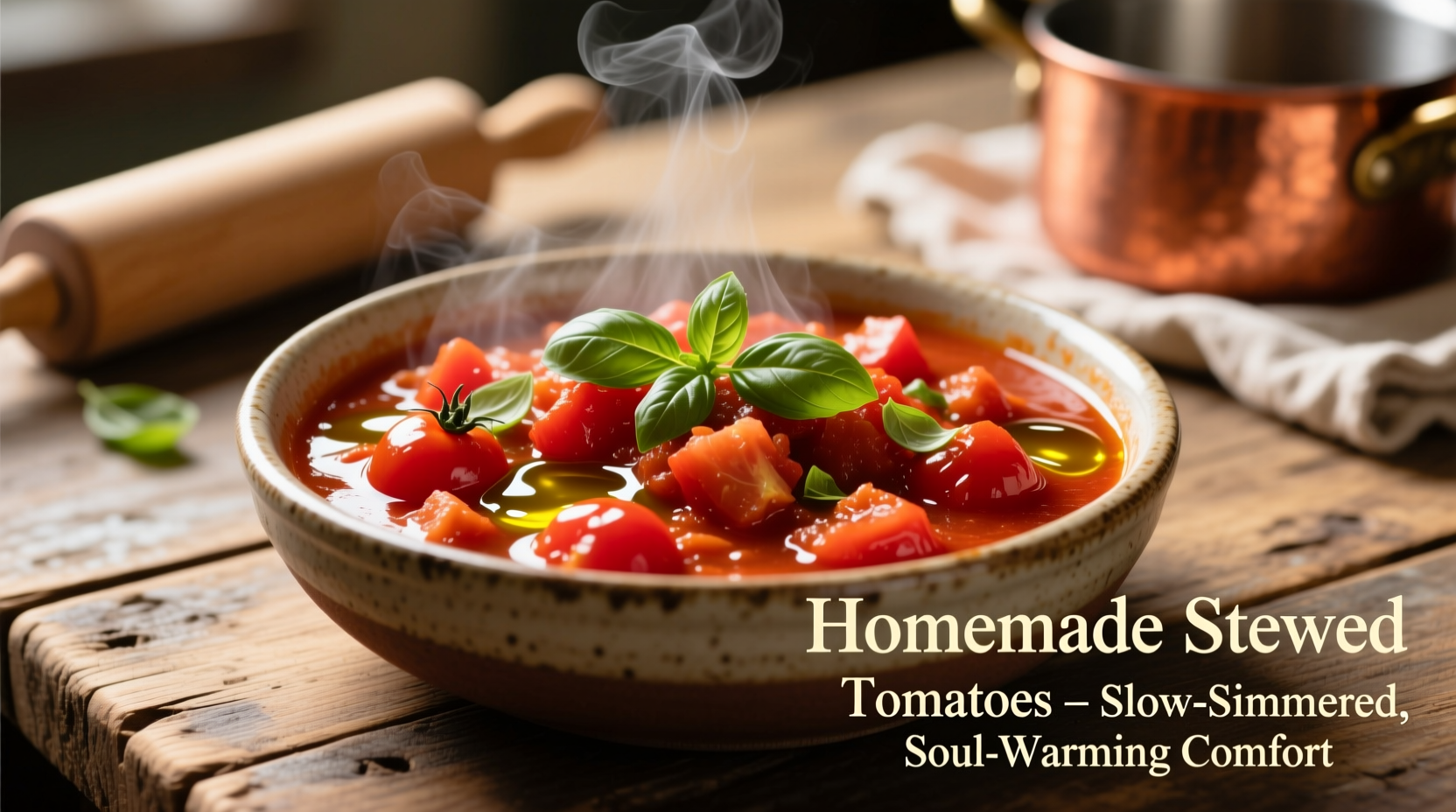Stewed tomatoes are tender tomato pieces simmered with herbs, onions, and seasonings. This versatile preparation differs from plain canned tomatoes by offering enhanced flavor through slow cooking with aromatic ingredients. A basic recipe requires just 6 ingredients and 45 minutes to create rich, flavorful tomatoes perfect for sauces, soups, or as a side dish.
Nothing transforms simple pantry staples into kitchen magic quite like perfectly stewed tomatoes. Whether you're crafting a comforting Sunday gravy, building layers in lasagna, or seeking a flavorful side for your grilled proteins, mastering this fundamental technique unlocks endless culinary possibilities. In this guide, you'll discover why home-stewed tomatoes consistently outperform canned versions, the precise techniques professional chefs use to develop deep flavor, and how to customize this versatile ingredient for any cuisine.
Why Stewed Tomatoes Deserve Your Attention
While canned stewed tomatoes fill grocery shelves, homemade versions offer superior texture and customizable flavor profiles. The difference lies in the controlled cooking process—allowing you to adjust seasoning levels, herb combinations, and cooking times to match your specific recipe needs. Unlike commercial versions that often contain unnecessary additives, your homemade batch contains only the ingredients you select.
| Tomato Preparation | Texture | Flavor Profile | Best Culinary Uses |
|---|---|---|---|
| Stewed Tomatoes | Firm yet tender chunks | Herb-infused, savory-sweet | Pasta sauces, braises, shakshuka |
| Canned Whole Tomatoes | Firm, intact pieces | Acidic, bright | Quick sauces, soups, stews |
| Tomato Passata | Smooth puree | Clean, fresh tomato flavor | Pizza sauce, delicate sauces |
| Tomato Paste | Thick concentrate | Intensely savory | Flavor base, color enhancement |
Essential Equipment Checklist
Before you begin, gather these kitchen essentials:
- Heavy-bottomed saucepan (3-quart minimum)
- Wooden spoon for gentle stirring
- Sharp chef's knife and cutting board
- Microplane grater for fresh garlic
- Acid-resistant container for storage
Step-by-Step Stewing Process
Follow this professional technique for consistently perfect results:
Preparation Phase (10 minutes)
- Select 2 pounds of ripe Roma tomatoes (plum varieties work best)
- Score an "X" on the blossom end of each tomato
- Blanch in boiling water for 30 seconds, then transfer to ice bath
- Peel skins starting from the scored end
- Cut into uniform 1-inch chunks, removing excess seeds if desired
Cooking Phase (30 minutes)
- Sauté 1 diced yellow onion in 2 tablespoons olive oil until translucent
- Add 3 minced garlic cloves and cook for 1 minute until fragrant
- Incorporate tomato chunks with their juices
- Add seasoning: 1 teaspoon salt, ½ teaspoon black pepper, 1 tablespoon sugar
- Include aromatics: 3 fresh basil stems, 1 bay leaf, optional red pepper flakes
- Cover and simmer on low heat for 25-30 minutes
- Remove herb stems before final seasoning adjustment

Flavor Variations for Every Cuisine
Customize your stewed tomatoes for specific dishes:
Mediterranean Style
Add 5 Kalamata olives (pitted and sliced), 1 teaspoon dried oregano, and 2 tablespoons capers during the last 10 minutes of cooking. Perfect for Greek-inspired dishes or topping grilled fish.
Italian-Inspired
Incorporate ¼ cup fresh parsley, 2 teaspoons dried basil, and 1 finely diced carrot during the sauté phase. Ideal for pasta sauces and eggplant Parmesan.
Spicy Arrabbiata Version
Add 1-2 finely diced fresh red chilies with the garlic and increase red pepper flakes to 1 teaspoon. Creates an authentic base for arrabbiata sauce.
Storage Guidelines and Safety Considerations
Proper storage ensures food safety and maintains quality:
- Refrigerate in airtight containers for up to 5 days
- Freeze in portion-sized containers for up to 6 months
- For canning: Follow USDA Complete Guide to Home Canning procedures (2023 edition) requiring pH testing below 4.6 and proper processing times
- Always leave 1-inch headspace in jars for proper sealing
The National Center for Home Food Preservation confirms that properly acidified tomatoes (pH below 4.6) can be safely processed in a boiling water canner for 85 minutes at sea level, with adjustments for altitude. Never attempt pressure canning without verified processing times from authoritative sources.
Troubleshooting Common Issues
Solve these frequent challenges:
Watery Consistency
If your stewed tomatoes release too much liquid, uncover during the final 10 minutes of cooking to allow evaporation. Alternatively, create a slurry of 1 teaspoon cornstarch mixed with 2 tablespoons cold water and stir in during the last 5 minutes.
Excessive Acidity
Balance sharp flavors with ½ teaspoon baking soda (add gradually) or increase sugar by ½ teaspoon increments. Always taste after each adjustment.
Mushy Texture
Overcooking or using underripe tomatoes causes this issue. Start with firm, ripe tomatoes and reduce cooking time to 20-25 minutes. The tomatoes should maintain distinct shape while being tender.
When to Choose Stewed Tomatoes Over Alternatives
Understanding context boundaries helps you select the right preparation:
- Use stewed tomatoes when you need flavorful tomato chunks that maintain shape in dishes like shakshuka or minestrone
- Choose tomato passata for smooth sauces where texture isn't important
- Opt for tomato paste when building foundational flavor in meat sauces
- Use whole canned tomatoes when you want to control the breakdown process yourself
Historical context reveals that stewed tomatoes became popular in American kitchens during the Great Depression as a way to stretch limited ingredients. The 1932 edition of The Joy of Cooking featured multiple stewed tomato variations, highlighting their versatility when fresh produce was scarce. This preparation method preserves summer's bounty while adding depth through slow cooking with available pantry staples.
Maximizing Flavor Through Technique
Professional chefs emphasize these often-overlooked details:
- Always add salt early in the cooking process to enhance flavor development
- Use fresh herbs at the beginning for subtle background notes, adding delicate herbs like basil at the end
- Include umami boosters like a Parmesan rind during simmering
- Finish with a drizzle of high-quality olive oil to enrich mouthfeel
Frequently Asked Questions
Can I use canned tomatoes instead of fresh for stewed tomatoes?
Yes, high-quality canned whole peeled tomatoes make excellent stewed tomatoes. Use one 28-ounce can with its juices, drain excess liquid if needed, and follow the same seasoning and cooking process.
How do I prevent my stewed tomatoes from becoming too acidic?
Balance acidity with natural sweeteners like carrots (added during sautéing), a pinch of baking soda, or small amounts of sugar. Always adjust gradually while tasting.
What's the difference between stewed tomatoes and tomato sauce?
Stewed tomatoes maintain distinct chunks with minimal thickening, while tomato sauce undergoes longer cooking to break down tomatoes into a smoother consistency with reduced liquid content.
Can I freeze stewed tomatoes successfully?
Absolutely. Cool completely, portion into freezer-safe containers with 1-inch headspace, and freeze for up to 6 months. Thaw overnight in the refrigerator before use.
Why do some recipes include a small amount of butter?
A tablespoon of butter added at the end creates a richer mouthfeel and helps balance acidity through its fat content, a technique known as monter au beurre in French cooking.











 浙公网安备
33010002000092号
浙公网安备
33010002000092号 浙B2-20120091-4
浙B2-20120091-4